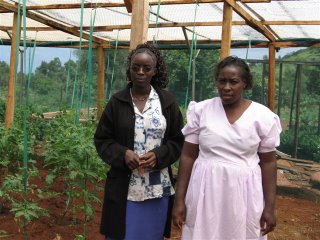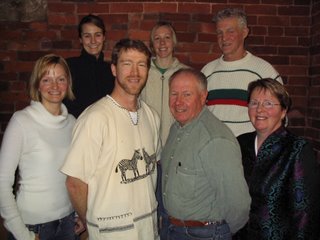

Wakulima visit Jan 23, 2007
Ken Mellish
We have come home to the Wakulima Dairy. Farmers Helping Farmers was introduced to the Wakulima Dairy ten years ago when it was a small Self Help group which was collecting several thousand liters of milk from its members in the mornings and selling it uncooled to Brookside Dairy near Nairobi. Now Wakulima Dairy is an incorporated company which collect 20,000 liters of milk a day from its members and offers a wide range of services including banking, veterinary services, feed store, and a milk testing lab. This dairy pumps $8,000 a day in to the area and the effects are seen everywhere.
Returning to Mukerweni where the dairy is located has that comfortable feeling of coming home. It starts before we arrive with a stop at the supermarket. We know the best place to shop from experience. The Uchumi at Karatina offers a wide selection of goods. We have a list including soap, salt, bottled water, beer rice and flour. The store has a wide range of goods including school supplies, some hardware and household goods. The store is clean and well lit. The goods are scanned out at the cash and bagged to carry out. Fresh fruit and vegetables will be bought at a traditional market where the vendors sit to sell bananas, mangos, cabbages and all other produce in season.
Arrival at the Wakulima Dairy is always exciting. There are changes starting at the front gate. Teresa’s tree has grown. A pine planted in 2002 is now about 30 feet high and has a fresh new sign with her name on it. On the other side there is a new sign with the Mukerweni Wakulima Dairy Ltd. The group has grown from a Self Help Group to an incorporated company. There is a group to greet us. Everyone is familiar except the new manager. There are hugs and a few tears. Again there are changes; the can wash bay is finished and there are new offices for the vet services.
After tea and an update on what old friends are doing we are down to business. We meet with the dairy management team from the board of directors. They are prepared for us dressed in “office casual” with a list of topics. We add our items to the list and the agenda is agreed.
There are old problems to deal with. Farmers Helping Farmers has funded a heat recovery unit for the milk cooler and it is not working. They have brought a refrigeration engineer to answer our questions. The milk cooling system is a 10,000 liter tank similar to those found on large farms in Canada. This is the key pieces of equipment which Farmers Helping Farmers funded in 1997 which allowed the dairy to cool milk. This allowed the dairy to pick up milk from the evening milking and cool it for shipment to Nairobi.
The heat exchanger will lighten the load on the tank compressors, halve the power requirement for cooling the milk and produce hot water for washing cans and the cooling tank. However the initial installation was not done correctly. The unit was not placed on a solid floor and filling and emptying with water caused it to flex the floor and break the coolant pipes. The cooling engineer offers a solution which involves relocation and an extensive installation of computerized controls for the cooling system. After a heated discussion we are able to simplify the plan and break the job into the relocation of the heat recovery system and the new controls. Practical experience from our Canadian farms allows to ask the right questions. We again find that things are the same world wide: engineers complicate things, tradesmen blame the previous tradesman for problems and the customer wants to pay less for more !
After the session in the milk cooling plant we are back to the board room. The next topic is biogas. At a previous visit some of the women have asked Teresa about biogas units. These would harvest cooking gas form cow manure. The gas would reduce the time the women needed to find firewood and reduce the destruction of trees. At that time the only units available were expensive concrete units. However, The Farmers Helping Farmers team had seen some highly efficient plastic tube units in Embu Kenya last year. These were demonstration units put in place by KARI. KARI is the equivalent of Agriculture Canada.
These units were very low cost, built with available materials and very efficient. Two buckets of mixed cow manure and water will generate enough gas to cook all the family meals. The key component is the plastic tube which is one meter across made of black sun resistant plastic. This tube is sold by Wakulima dairy for their farmers to store Napier Grass silage. Again the management has brought in an expert and again the task is to ask the questions that simplify the job and reduce the cost. It is agreed that Farmers Helping Farmers will fund two units to demonstrate the process and then if CIDA money is approved the number can be scaled up. The details of implementation are delegated. Ken and Gerald will discuss details tomorrow and Bernard will be the staff member who will be responsible for implementation. It is satisfying to see how the Wakulima board works and the familiarity with the Canadians makes work easy. There is trust enough for disagreements and a sense of working with people which have been your partners.
The next item is schools. Almost every Wakulima board member sits on a school board. Farmers Helping Farmers has become very involved in the local schools. Three of the local schools are twinned with Prince Edward Island schools and each year several preservice teachers from UPEI come to this area to get their international experience. Teresa has twinning letters for exchange and a list of cheques. These are from donations in PEI and will be used for school books and school improvements. The following day Teresa and Gerald will visit the schools, deliver the cheques and make plans to come back in two weeks to see the books and get photos for the donors. There are ten schools on the list!
The next two items on the list involves other dairies. The near by Embu dairy is a new partner with Farmers Helping Farmers and they would benefit from mentoring by the Wakulima group. The Wakulima group agrees to host the Embu group next Thursday and discuss their plans. Again details are delegated.
Also, Farmers Helping Farmers is looking for new partners. As projects mature it is time to move on to other groups. We will need Wakulima assistance to access new dairy partners. A plan is made for tomorrow. James, the vice chair of Wakulima, Ken, Daniel, Shaad and Esther, Wakulima treasurer will travel to Othaya Dairy for a first visit. Esther is key as a Kenyan woman who understands the value of a shilling and tolerates no waste. She will send the message that money must be accounted for to the last shilling and that women are to be treated as equal partners. It is only a half a hours drive and the activity should only take the morning. The new dairy has already made a presentation to the Farmers Helping Farmers council here in Kenya and has some concept of how we work.
Lunch back at the house is time to catch up on news. They ask about Sandra MacKinnon, the “bee man” Stan , Trudy and Liz. Also there are questions about visitors from early years: Karl Winter and Katie van Ekris.
In the afternoon there is time for a quick visit to the SACCO; a credit union. Several years ago the dairy proposed that we supply some funding for dairy cow loans. Credit was difficult to get for farm loans and interest rates were very high. Farmers Helping Farmers with CIDA assistance provided $40,000 for a revolving loan. We have been getting reports that the money was loaned out, repayments were coming in and new loans had been made. The first impression at the SACCO is that there were no long line-ups of customers which we saw previously. We meet with Paul the manager and find out that computerization is complete and the service time for members has been cut dramatically. He also tells us that the SACCO now has 11,000 active members. We get some stories about the cow loans how they have accumulated 1,000,000 shillings (60 ksh/ $CND) from repayment and will soon call for new loan requests. They interview all applicants and have learned what questions to ask. Two of the cows purchased under this program have died and one owner also has died. The loan was life insured so repayment will be possible. The reports are good and everyone is upbeat because of the rain and good crops.
Milk income is paid through the SACCO and farmers are able to get advances for school fees, vet fees, feed and food in times of food shortages.
Daniel has gone in a different direction for the afternoon. He has gone out on a “milk pick-up route”. This involves going out to pick up milk from the farmers along the roads of the district. The truck, or lorry as it is called here, is a one ton with a rack on the back. It is loaded with empty 40 liter cans and equipped with a scale to weigh milk. The truck drives to various stops in the district where farmers line up with their cans of milk. Yesterday this varied from one half a liter to 30 liters. Each can is presented to the weigher on the truck, the milk is weighed and the farmer’s card is filled in with the amount of milk delivered. These weights are recorded on the weigher’s report and entered in to the dairies computer. At the end of the month the milk income is deposited into the farmer’s account at the SACCO.
Most of the farmers delivering milk are women who do the bulk of the work on the small farms. They have seen Canadians on the milk truck before and there is quick recognition. Everyone knows that it is the Canadians who made it possible for the dairy to expand and enable the community to prosper. Milk is picked up from 250 farmers and the truck returns with is load of filled cans to be dumped into the cooling tank.
Daniel says the experience is indescribable. It is so different from the Prince Edward Island experience where a bulk truck back up to the farm tank and pumps off 4,000 liters of cooled milk in a few minuets. However, this is a place to meet people and neighbors visit and exchange news. We are sure that a Prince Edward Island farmer in the back of a Kenyan milk truck helping to empty cans would be a hot topic on the way home from the milk collection point.
Later in the evening we sit and discuss the day. There are two power outages and we scramble for flashlights using cell phone light to find the way. It has been a big day and tomorrow will be another one












